Search Results for 'the Galway Vindicator'
23 results found.
Old Galway newspapers

The first book printed in Ireland was The Book of Common Prayer in 1551. As printing became more sophisticated, newspapers became inevitable. The first gazettes were published originally in manuscript – the word gazette being derived from gazetto, a coin of Venice, the amount paid for reading the news. The earliest printed newspapers began to appear around the end of the 16th century. These were small, quarto in size, printed on one or both sides of the page, or of four pages containing intelligence of public interest which were variously called 'Books of Newes', ‘Newe Newes’, 'Wonderful Newes', ‘Bloody Newes out of Ireland’, etc.
The saga of the great ship continues
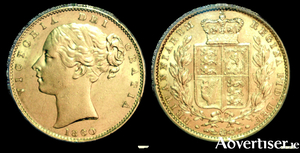
During the last week of October 1860 members of the crew of the Connaught began to return to Galway. On October 28 the first to arrive came by train ‘where a large number of people on that afternoon were at the station to welcome them back.’
The sinking of the PS Connaught, and tragedy miraculously avoided
There can be no greater horror for passengers and crew than facing death on a burning ship in a heavy sea, that was sinking by its bow. Which death would you choose? Stay on board and be burnt? Or chance your luck in the waves?
Grattan Road
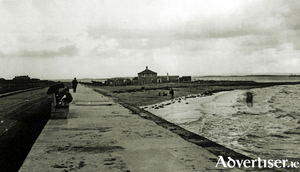
Crane’s Strand or Tráigh na gCorr appears on the 1651 map. It would seem to be the Whitestrand area before the building of Grattan Road. In Dutton’s 1824 survey we read: “It seems to be the general opinion of the oldest inhabitants that for some years past, storms and rains have been more frequent from the west than formerly. (Rice was sown here in 1585). As some corroboration of this idea, the encroachment of the sea near Recorder’s Quay on the west side of Galway, may be adduced, where the marks of the potato ridges may be seen, and where, only a few years ago were in cultivation, though they are now covered at every tide. Lately, the ground near Recorder’s Quay has been reclaimed by Mr Bulteel, and promises to remunerate his very spirited exertion.” (Probably the first ever reclamation of land in Salthill).
The guns in the Square
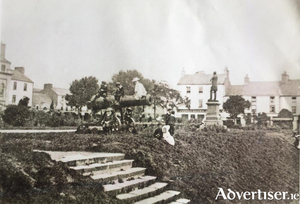
The Galway Vindicator of July 25, 1857, reported the arrival in Galway on board the SS Lady Eglinton, of two cannon, which had been shipped from Woolwich Arsenal, the main storage and distribution depot of Crimean War ordnance. These cannon, described as “64-pounders of a heavy and clumsy description, each weighing two tons,” were taken from the docks to the goods yard beside the railway station, where they were made ready for the handing over ceremony. They were part of a significant amount of Russian ordnance which had been captured in 1854 by the 88th Regiment at the Battle of Inkerman during the Crimean War. They were two of a number of artillery pieces that were presented by the war department to various cities as trophies.
Salthill - ‘One of the nicest localities in the Kingdom.’
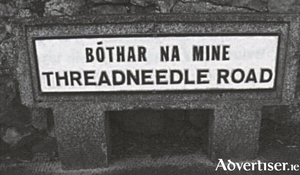
Salthill was a quiet fishing village, existing independently from Galway town, until the Victorian obsession for health and fresh air eventually came to the west of Ireland. Invigorating salt-sea baths, salt-water showers, and, as I mentioned in former weeks, confined bathing opportunities for women; but where men could hire togs for some manly swimming and diving. By 1828 it was noted that there were 40 to 50 neat lodges along its sea shore, where there were only two or three a few years before.
A Galway tradition
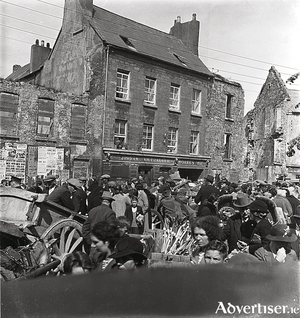
In Hely Dutton’s Survey of Galway in 1824, he reported; “The vegetable market near the Main Guard is generally well supplied, and at reasonable rates; all kinds come to the market washed, by which any imperfection is easily detected. The cabbage raised near the sea on seaweed is particularly delicious; those who have been used to those cultivated on ground highly manured cannot form any idea of the difference. There are also, in season, peaches, strawberries, gooseberries, apples, pears etc.”
A Commercial Club excursion to Cong, 1915
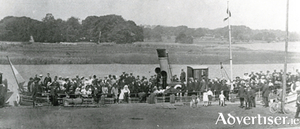
The Commercial Rowing Club was set up in May 1875. The Corrib Rowing and Yachting Club had been in existence since 1864, but as it was the only such club on the river, there was a distinct lack of competition for its oarsmen. Commercial provided that competition.
Waiting at Tiffany’s on Broadway
In the Diary of September 22 I asked whether the ‘gallant and humane’ Captain John Wilson of the The Minnie Schiffer, who miraculously snatched from certain death 591 passengers and crew from the burning PS Connaught, ever received the ‘elegant service of plate’ especially commissioned for him from the prestigious Tiffany and Co of Broadway, New York. The plate was paid for by the merchants of New York and Boston ‘in appreciation of his gallant conduct at sea’ on that fateful evening October 8 1860.
The Galway Observer
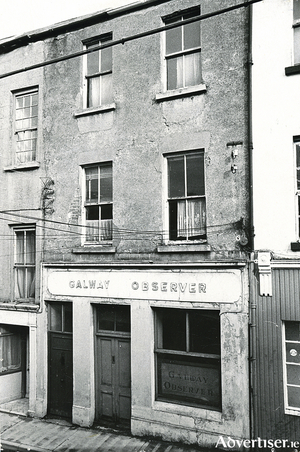
Fifty years ago this weekend, on October 1 1966 to be precise, the last issue of the Galway Observer newspaper was published. It was founded in 1881, published on a Thursday (which was a half day in Galway) and circulated extensively in the city and county. In 1905 it declared itself as the “official advertising medium for the following public bodies – The Galway County Council, The Galway Town Council, Galway Rural District Council and Board of Guardians, Loughrea Rural District Council and Board of Guardians, Gort Rural District Council and Board of Guardians, Clifden Rural District Council and Board of Guardians, Galway Harbour Board, etc, etc.

